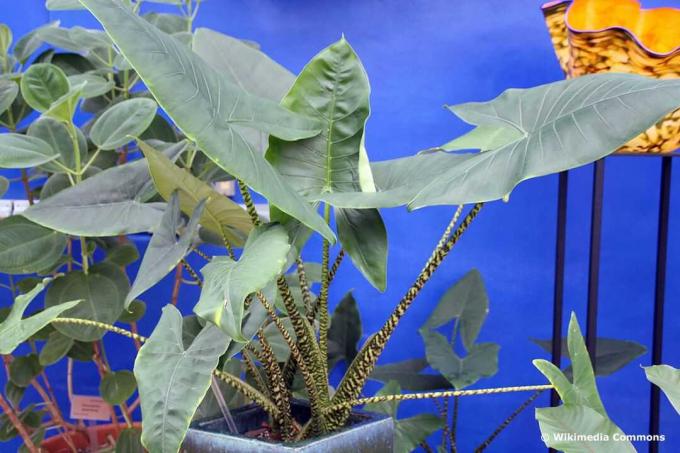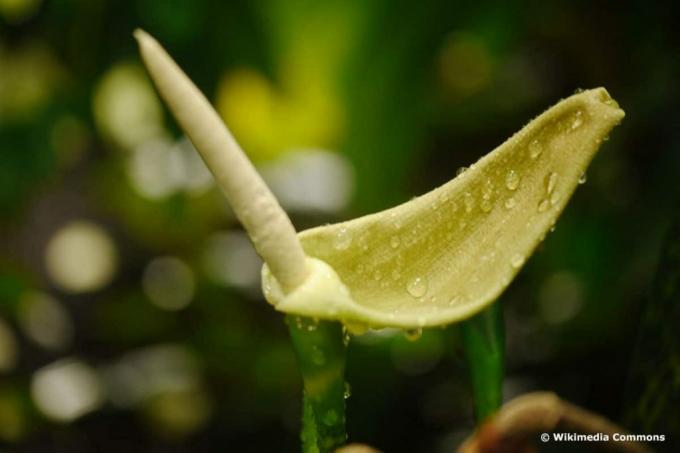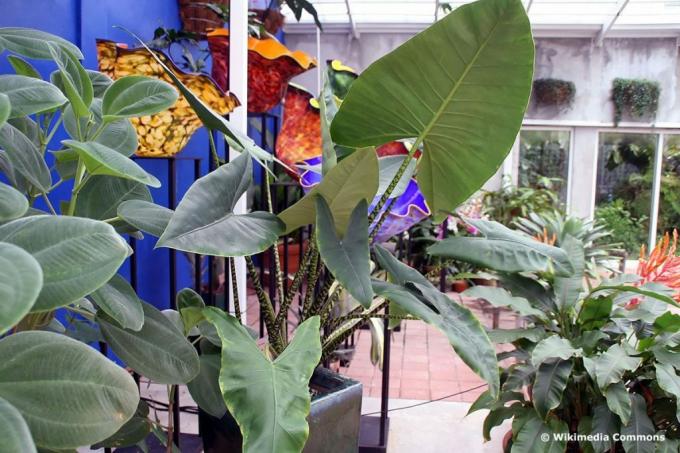
table of contents
- Location
- temperature
- humidity
- Substrate
- to water
- Fertilize
- Cut
- Repot
- frequently asked Questions
The Alocasia zebrina, because of the shape and size of its leaves, also called an arrow leaf or Elephant ear is an attractive houseplant. In order for the alocasia to grow and thrive vigorously, it needs the right location and special care.
In a nutshell
- bright, but not directly sunny location
- at least five hours of sun a day
- no midday sun
- Keep the substrate slightly moist, high humidity
- Fertilize weekly with green plant fertilizer
Location
Alocasia zebrina is native to the subtropical and tropical rainforests of Southeast Asia and is mainly found in the Philippines. So it is a forest plant that feels most comfortable in a bright, but not directly sunny location. You can put it against a window, but not exactly against one South window or at least 15 centimeters away. The midday sun, which is very intense in summer, should be avoided in particular, as it causes leaf burns and thus unsightly brown spots.
- ideally on a window facing east or west
- about five hours of sun exposure a day
- shade over lunchtime if necessary
- Partial shade, no shade

Note: With the appropriate pot size and good care, the Alocasia zebrinain indoor culture can be up to two meters high. So offer it enough space for growth, for example with a space on the floor or a plant stool.
temperature
As a tropical plant, the alocasia does not tolerate cold temperatures, which you should consider when caring for it. During the vegetation period between April and October 20 to 25 ° C are optimal, in winter it can be a bit cooler. During this time, the plant should be allowed to go into hibernation, especially since the light irradiation in Central Europe is often insufficient.
- in winter quarters no cooler than 18 ° C
- good winter quarters: bright staircase, little heated living rooms
- alternatively, warm room culture with plant light
- in winter not over or near a heater
Tip: A good place for wintering is, for example, the bedroom, as this is not very heated. However, this only applies if it is not facing north and therefore too dark. The bathroom is also suitable as a location for the Alocasia zebrina with good care.
humidity
Another characteristic of tropical rainforest plants is the need for high humidity. So that the large leaves of the alocasia can develop vigorously, as is typical of the species, you should spray and care for the plant daily with lime-free water. Use rainwater or stale tap water, otherwise there will be unsightly limescale stains on the leaves. The water spray should also be room temperature and under no circumstances should it be cold. You can also give the arrow a vigorous shower with lukewarm water once a week. This acts like a natural rain shower and also has the effect that the large leaves are freed from deposited dust.

Note: A high level of humidity should be maintained, especially during the winter heating season, as otherwise the plant is quickly attacked by spider mites due to the weakening.
Substrate
A loose, nutrient-rich houseplant substrate is ideal for alocasia. If you choose a pre-fertilized product, you will save yourself fertilizing in the first year after potting. So that waterlogging, which the plant cannot tolerate at all, cannot develop in the first place, the plant pot needs a drainage hole in the bottom. In addition, a few centimeters of expanded clay balls come in as the bottom layer, only then do you fill the soil. Mix this with some pine bark or granite rock flour to lower the pH. Alocasias are preferred in slightly acidic soil.
to water
Since the large leaves permanently release water, the Alocasia zebrina has a high water requirement, which you should consider when caring for it. The substrate should always be kept slightly moist and should only dry out. You should absolutely avoid drying out. However, do not water too much to avoid waterlogging. If the leaves develop yellowish-brown edges, water less in the future. We cannot give you specific watering recommendations, as the water requirement depends individually on the plant, its location, the surrounding humidity and temperature. It is best to do the following:
- perform finger tests regularly
Is the substrate:
- damp: do not water
- dried: add a small amount of water
- dry after two days: water a little more
- still damp after a week: water less next time

In this way, you gradually feel your way towards the optimal amount of water for your arrow leaf and get a feel for how much water the plant actually needs. There is an urgent need for water when the stems are no longer upright. In winter, on the other hand, the alocasia needs less water, but still must not dry out. Alocasias are very suitable for hydroponics. Alternatively, you can use clay cones (e.g. B. Blumat) or another irrigation aid ensure an optimal water balance.
Tip: Always place Alocasia on a waterproof surface and not necessarily on the expensive wooden living room wall, as with a good water supply some water will always drip from the leaves. This is completely normal and cannot be avoided.
Fertilize
With good care, a healthy Alocasia zebrina is characterized by vigorous growth, which is why you should fertilize it weekly during the growth period between April and October. A liquid fertilizer for green plants is ideal, which you dilute with the irrigation water according to the manufacturer's instructions and give it to the plant. Fertilization is not necessary between October and March. Even after repotting in fresh, pre-fertilized substrate, there is no need to fertilize.

Cut
Over time, the lower leaves of the alocasia turn brown, which is also perfectly normal. Older leaves are no longer supplied by the plant because it puts its energy into the growth of new leaves. Therefore, the old foliage dies and should be cut off. The same applies to leaves that have died or are severely discolored or diseased during hibernation. Don't worry, the alocasia is constantly forming new leaves so that it does not become bald. This is why you can remove particularly wide leaves even if the plant has grown too big. A shape cut, however, is not necessary.
Repot
Since the Alocasia zebrina grows quite quickly, you should move it every two to three years in fresh substrate and in a larger pot. To do this, simply lift the plant out of the old pot, carefully remove the old soil and plant the alocasia in the prepared, new plant pot again. This should be about two sizes larger than the previous one. Be careful not to damage the roots when transplanting. It also makes sense to finally place the plant pot in the planter on an insert so that the roots do not stand in the excess irrigation water.
frequently asked Questions
Different, sometimes even contradicting reasons can lead to the alocasia getting yellow leaves. For example, both too much and too little water cause the discoloration, which is why you should always refer to the You should pay attention to the moisture of the substrate - if it is wet and the leaves are yellow, it is probably on Waterlogging. However, a lack of nutrients, for example due to insufficient fertilizer or because the plant has not been repotted for too long, can be the cause.
Alocasia zebrina is harmless to humans, after all, in Southeast Asia its roots are even boiled and eaten as a vegetable. Nevertheless, caution is advised because the sap is irritating to the skin and mucous membranes. Neither you nor your pets should consume raw parts of the plant, as this can lead to upset stomachs.
The Alocasia zebrina can easily be propagated by cuttings that grow with sufficient pot size. As soon as these daughter plants have at least four leaves, you can separate them from the mother plant and plant them separately. It is best to do this the next time you repot in spring.
